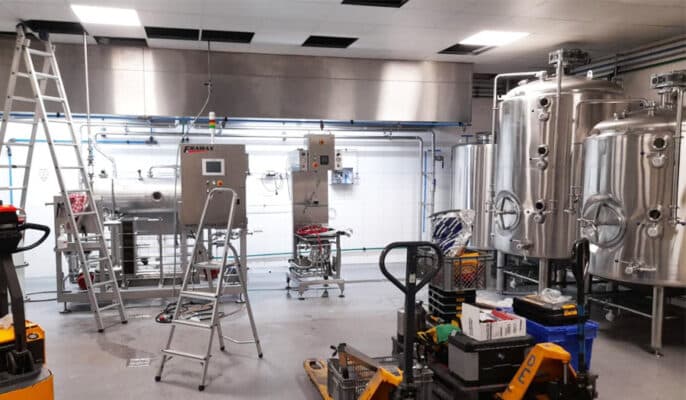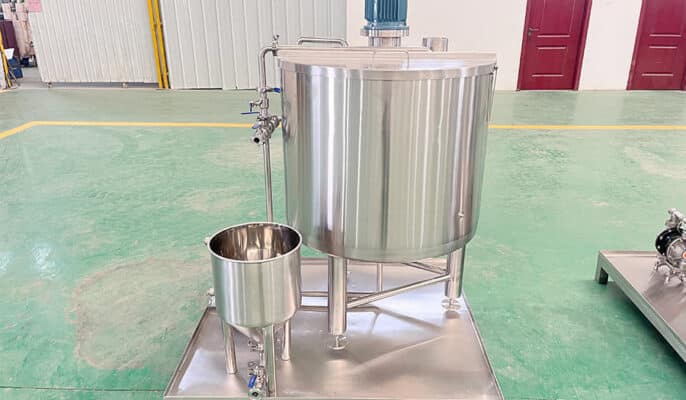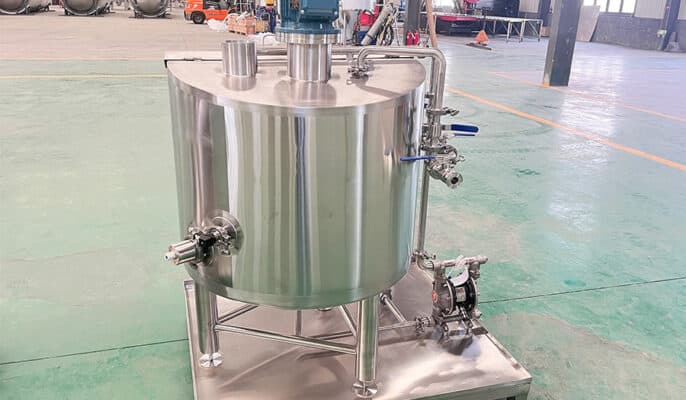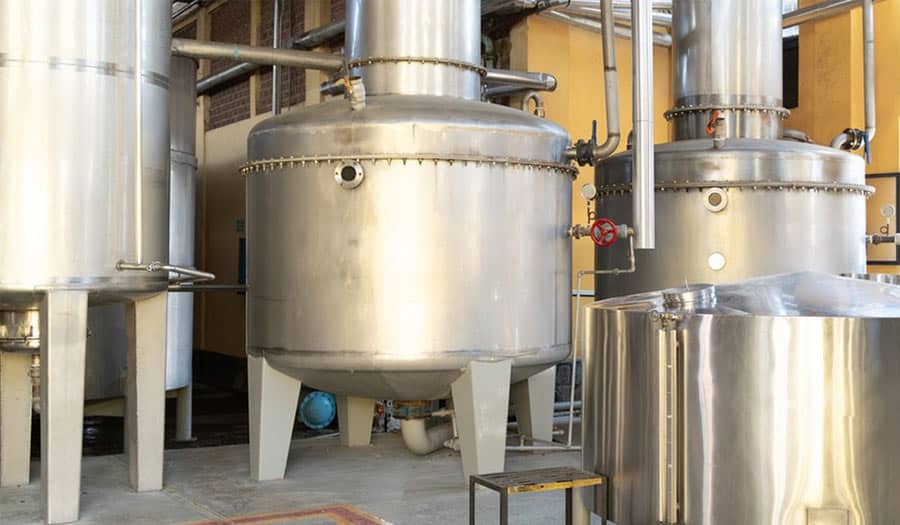In modern industrial production, the mixing tank with an agitator is an indispensable equipment.It is widely used in chemical, pharmaceutical, food, coating, dye, and other industries for mixing, stirring, reaction, and other processes. The design and performance of the mixing tank directly affect the quality and production efficiency of the product. This article will introduce the structure and type of the mixing tank with agitator in detail.
무엇인가요? 혼합 탱크?
The mixing tank is an important piece of equipment widely used in industrial production. From a structural point of view, it mainly comprises a tank body, a stirrer, a transmission device, a sealing device, a heating or cooling device, and an inlet and outlet. The tank body is usually made of strong materials such as stainless steel and carbon steel. It has different shapes such as cylindrical, conical, and elliptical to meet various process requirements. As the core component, the agitator is installed in the tank body and rotates through the transmission device to obtain power, so that the materials in the tank are fully mixed and stirred. The transmission device is generally composed of a motor, a reducer, a coupling, etc., which provides stable and suitable power for the agitator.

Characteristics of the mixing tank
Diverse structures and configurations
The mixing tank can be made of carbon steel, stainless steel, and other materials according to the requirements of the production process, and heating and cooling devices can be set to meet different processes and production needs. The heating forms include jacket electric heating, coil heating, etc. These designs enable the mixing tank to adapt to various complex production environments.
Efficient mixing performance
The mixing tank uses the rotation of the agitator to shear, stir, and mix different materials, thereby achieving uniform mixing. The speed, shape of the agitator, and the properties of the material will affect the mixing effect. Accessories such as baffles and guide tubes in the mixing tank can further improve the mixing efficiency and ensure the uniformity of material mixing.
Flexible control system
The mixing tank can realize feed control, discharge control, stirring control, and other manual and automatic controls during the mixing process. These control systems make the operation of the mixing tank more flexible and convenient and can meet the needs of different production processes.
Reliable sealing performance
The shaft seal device of the mixing tank is an important part of the mixing equipment. Its function is to ensure that the mixing equipment is in a certain positive pressure or vacuum state to prevent the escape of the stirred material and the infiltration of impurities. As a commonly used shaft seal, the mechanical seal has the advantages of reliable sealing, long service life, low friction power consumption, etc., and can meet the sealing requirements under various complex working conditions.
Humanized design and operation
The design structure and configuration of the mixing tank can be standardized and humanized, making the operation easier. At the same time, the cleaning and maintenance of the mixing tank are relatively convenient, which can reduce production costs and improve production efficiency.
The structure of the 혼합 탱크
The mixing tank with an agitator is mainly composed of a tank body, agitator, transmission device, sealing device, heating or cooling device, inlet and outlet, etc.
Tank body
The tank body is the main part of the mixing tank, usually made of stainless steel, carbon steel, and other materials. The shape of the tank body is cylindrical, conical, elliptical, etc., which is selected according to different process requirements. The volume of the tank body also varies, ranging from a few liters to tens of cubic meters. The inner wall of the tank body is usually polished to ensure the cleanliness of the material and prevent the material from adhering.
교반기
The agitator is the core component of the mixing tank, and its function is to fully mix and stir the material in the tank body. There are many types of agitators, the common ones are paddle agitators, turbine agitators, anchor agitators, ribbon agitators, etc. Different types of agitators are suitable for different materials and process requirements.
- Paddle agitator: The paddle agitator is simple-structured and highly versatile. It consists of two or more blades, which are usually flat and mounted on the agitator shaft. The stirring speed of the paddle agitator is low, and it is suitable for mixing and stirring materials with low viscosity.
- Turbine agitator: The turbine agitator is a high-speed agitator composed of multiple blades, and the shape of the blades is similar to that of a turbine. The stirring speed of the turbine agitator is fast and the shear force is strong, which is suitable for mixing and stirring materials with high viscosity.
- Anchor agitator: The anchor agitator is a stirrer with a shape similar to that of an anchor. It has a large stirring area and is suitable for stirring materials with high viscosity and easy to adhere to the tank wall. The stirring speed of the anchor agitator is low and is usually used in conjunction with other types of agitators.
- Ribbon agitator: The ribbon agitator is a stirrer composed of spiral blades. It has a wide stirring range and is suitable for mixing and stirring materials with high viscosity. The stirring speed of the ribbon agitator is low and is usually used in conjunction with other types of agitators.
Transmission device
The transmission device is a component that transmits power to the agitator, and is usually composed of a motor, a reducer, a coupling, etc. The motor is the power source of the mixing tank. Motors of different powers are selected according to the size of the mixing tank and the process requirements. The function of the reducer is to reduce the speed of the motor and increase the torque of the agitator. The function of the coupling is to connect the motor and the reducer to transmit power.
Sealing device
The sealing device is a component that prevents material leakage and external impurities from entering the mixing tank, usually composed of mechanical seals, packing seals, etc. Mechanical seals are sealing devices with good sealing performance and long service life, suitable for occasions with high sealing requirements. Packing seals are sealing devices with simple structures and low cost, suitable for occasions with low sealing requirements.

Heating or cooling device
The heating or cooling device is a component used to control the temperature of the material in the mixing tank, usually composed of a jacket, coils, etc. The jacket is a sleeve installed on the outside of the tank body, which heats or cools the material in the tank body by passing steam, hot water, or cold water. The coil is a spiral pipe installed in the tank body, which heats or cools the material in the tank body by passing steam, hot water, or cold water.
Inlet and outlet
The inlet and outlet are components used for materials to enter and exit the mixing tank, usually composed of valves, pipes, etc. The location and quantity of the inlet and outlet ports are designed according to the process requirements to facilitate the entry and exit of materials and operation.
혼합 탱크의 종류
Classification by Tank Shape
- Cylindrical Mixing Tank: Cylindrical mixing tank is the most common type of mixing tank. Its tank body is cylindrical, with a simple structure and convenient manufacturing. It is suitable for mixing and mixing most materials.
- Conical Mixing Tank: The tank body of the conical mixing tank is conical, and the bottom is a conical structure, which is conducive to the discharge of materials. A conical mixing tank is suitable for mixing and mixing materials with high viscosity and easy precipitation.
- Oval Mixing Tank: The tank body of the oval mixing tank is oval, with a compact structure and small footprint. It is suitable for occasions with limited space. The oval mixing tank is suitable for mixing and mixing various materials.
Classification by Agitator Type
- Paddle Mixing Tank: The paddle mixing tank adopts a paddle agitator with a low stirring speed. It is suitable for mixing and mixing materials with low viscosity.
- Turbine Mixing Tank: The turbine mixing tank adopts a turbine agitator with a fast stirring speed and strong shear force. It is suitable for mixing and mixing materials with high viscosity.
- Anchor-type mixing tank: The anchor-type mixing tank adopts an anchor-type agitator, which has a large stirring area and is suitable for stirring materials with high viscosity and easy to adhere to the tank wall.
- Screw-type mixing tank: The screw-type mixing tank adopts a screw-type agitator, which has a wide stirring range and is suitable for mixing and stirring high-viscosity materials.
Classification by operation mode
- Intermittent mixing tank: The intermittent mixing tank is a mixing tank operated in batches. After the materials are stirred and mixed in the tank body, the materials need to be discharged from the tank body before the next batch of materials is stirred and mixed. Intermittent mixing tanks are suitable for stirring and mixing small batches and multiple varieties of materials.
- Continuous mixing tank: The continuous mixing tank is continuously operated. The materials are continuously stirred and mixed in the tank body and continuously enter and exit the tank body. The continuous mixing tank is suitable for stirring and mixing large batches of single varieties of materials.
Classification by heating or cooling method
- Jacketed mixing tank: The jacketed mixing tank is a layer of jacket installed on the outside of the tank body, and the materials in the tank body are heated or cooled by passing steam, hot water, or cold water. The jacketed mixing tank is suitable for occasions where temperature control requirements are not high.
- Coil-type mixing tank: The coil-type mixing tank is a tank with a spiral coil installed in the tank body, and the material in the tank body is heated or cooled by passing steam, hot water, or cold water. The coil-type mixing tank is suitable for occasions where temperature control requirements are high.
- Electric heating mixing tank: The electric heating mixing tank is an electric heater installed outside the tank body, and the material in the tank body is heated by the electric heater. The electric heating mixing tank is suitable for occasions where temperature control requirements are high and the heating area is small.

Application of mixing tanks
- Chemical industry: In the chemical industry, mixing tanks are used for various chemical reactions, mixing, dissolving, and other processes. For example, in the production process of synthetic resins, plastics, rubber, coatings, etc., mixing tanks are needed to mix and react with various raw materials to obtain the desired products.
- Pharmaceutical industry: In the pharmaceutical industry, mixing tanks are used for mixing, stirring, dissolving, fermenting, and other processes of drugs. For example, in the production process of drugs, mixing tanks are needed to mix and stir various raw materials to obtain uniform pharmaceutical preparations.
- Food industry: In the food industry, mixing tanks are used for mixing, stirring, fermenting, seasoning, and other processes of food. For example, in the production process of beverages, dairy products, condiments, etc., mixing tanks are needed to mix and stir various raw materials to obtain food products with good taste.
- Coating industry: In the coating industry, mixing tanks are used for mixing, stirring, dispersing, and other processes of coatings. For example, in the production process of paints, coatings, inks, etc., mixing tanks are needed to mix and disperse various pigments, fillers, resins, and other raw materials to obtain uniform coating products.
- Dye industry: In the dye industry, mixing tanks are used for dye mixing, stirring, dissolving, and other processes. For example, in the dye production process, a mixing tank is needed to mix and dissolve various dye raw materials to obtain the desired dye product.
결론
The mixing tank with agitator is an important industrial equipment, which plays an important role in the chemical, pharmaceutical, food, coating, dye, and other industries. The design and performance of the mixing tank directly affect the quality and production efficiency of the product. When consulting on the selection of mixing tanks, you can consult micet group, which manufactures and supplies sanitary, food-grade mixing and provides various mixing solutions for various industries.




